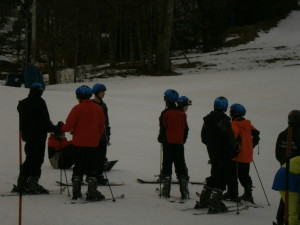A Scout unit participating in an outdoor activity is generally comprised of a mixture of both youth and adults, of differing ages, skill levels, maturity levels, and physical conditioning . . . not to mention, differing views of their own abilities, some accurate, some not.
It may nonetheless be tempting for an adult leader, particularly one of lesser experience, to first look to their own ability and skill level to determine if a planned activity should either proceed as planned, or continue in the face of unexpected challenges (be it weather or other issues). This is not unexpected, as adults out of habit might first look to their own ability to meet activity challenges placed before them in their daily lives.
However, adult leaders, as legal guardians for those youth participating in the activity, must also look elsewhere when making such determinations. Indeed, determining the “weakest link” in the group, as defined by criteria such as ability, fitness, maturity, and skill level (adult or youth), should be a continual focus of any adult leader during the planning and conduct of the activity.
Perhaps, for example, a gear deficiency might factor into the determination of the “weakest link”, apart from any physical limitations, such as a pair of hiking boots which will not survive a backpacking trip.
The weakest link may also be a weak swimmer during a rafting trip, adult or youth, or whose physical condition might come into play when a raft capsizes.
During one of the author’s high adventure packrafting treks, the weakest link was a scout with a recovering ankle injury, which had to be taken into account during any backpacking segments of the trek.
Of course, depending on a change in conditions or circumstance, the “weakest link” might change from one person to another. And, the identity of the “weakest link” might change during the activity!
A participant in one of the author’s risk management courses, recognized this point, making the following comment:
“One of the best lessons for me was the difference between risks that my hiking buddy and I might take with 25+ years of hiking experience (and only ourselves to worry about), and the proper duty of care when taking Scouts on an adventure.”

For instance, for a troop participating in a downhill ski weekend, under challenging conditions of cold and significant wind chill, a decision as to whether to proceed must necessarily take into account the ability of each individual youth to satisfactorily function under such conditions, apart from whether the adult leader believes that they themselves (or the majority of youth) may safely function in that environment.
Or, the risks associated with conducting a lengthy hike under conditions of (1) high heat and humidity, or (2) altitude, must be considered in relation to each of the youth and adult participants, focusing on the risks associated with participation by any participant (youth or adult) deemed to be potentially the most challenged by the activity.
Indeed, scouts have perished as a result of hiking in conditions of high heat and humidity, or high altitude. Was this the result of ignoring the environmental effect on specific members of such groups? Was this the result of someone saying “I’m ok, so everyone else must be ok.”? Or, was it a result of those in a supervisory position ignoring the weakest link by failing to continually assess the condition of each member of the group during the activity, instead unconsciously becoming a mere participant themselves to the detriment of others?
This is just a reminder that bad events can happen quickly, or they can happen slowly, and such “bad events” might be prevented by maintaining a constant awareness of the condition of the members of the group during the activity, being continually aware of who the “weakest link” might be at any given time, and exercising competent judgment regarding the conduct of the activity accordingly.
